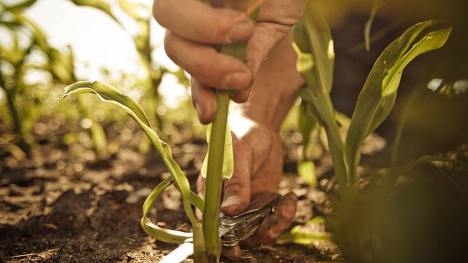Benefits of Plant Tissue Testing in Soybeans and Corn

Every year, growers are looking for an edge to help push their soybean varieties and corn hybrids to reach their maximum yield potential. Plant tissue testing can be a useful tool to help you reach your yield goals. Knowing the nutrient levels of your plants can help you diagnose problems and opportunities, take immediate action, and/or help you make decisions for the following season. Plant tissue testing is best used alongside soil testing to help you develop a fertility program.
Here’s how it works. Plant tissue testing measures the macro and micronutrient content in the plant at the time of sampling. This allows for a few things, 1) troubleshooting and diagnosing suspected nutrient deficiencies or reveal hidden nutrient stresses, 2) identifying and monitoring the plant’s nutrient status and how well the plants are utilizing the soil and applied nutrients, and 3) enabling decisions on side-dress and foliar nutrient applications.
Here’s how to do it. For soybeans, two samples can be taken, 1) early in the season at the 1st to 3rd trifoliate, and 2) later in the season at early bloom to pod set. For “early in the season” cut the plant 1 inch above the soil surface and submit the entire plant to the laboratory. For “later in the season” cut the 1st fully developed trifoliate from the top of the plant and submit the trifoliate. For both early and later season samples, 20 to 30 plants should be collected and submitted from the sampling area.
Courtesy of PennState Extension

For corn, three samples can be taken, 1) when the plant is 0 – 12 inches tall, 2) >12 inches but prior to tasseling, and 3) tasseling to pollination. When sampling “0-12 inches” cut half above soil surface and submit entire plant. For “>12 inches to tasseling” find the first fully developed leaf from the top of the plant (first leaf below the whorl), cut it at its base where it joins the sheath and submit the leaf, and 3) at the “tasseling to pollination” stage, find the leaf below the ear, cut it at its base where it joins the sheath and submit the leaf. Submit 20 to 25 samples from each area.
Corn

Courtesy of PennState Extension

Here are some watchouts. There are a few things that can skew the results. Excess moisture or severe drought can hold back plant growth and affect nutrient uptake. If the plant growth is held back due to drier conditions, nutrient levels in the tissue could become more concentrated. In the case of severe drought stress or in flooded conditions, nutrient uptake may be limited due to environmental factors and not by nutrients available in the soil. Diseased and/or pest damaged foliage should not be sampled for tissue testing because these can also affect the nutrient levels in the plant.
Here are a few reminders. Tissue tests provide a glimpse of the nutrients the plant was able to access from the soil. It does not tell you whether the nutrients are deficient in the soil. They can, however, help identify the underlying cause of nutrient deficiency, and, in turn, help you develop a solution. Tissue testing complements soil testing and together can be effective tools to develop your fertility program. Feel free to contact your local agronomist and your NorthStar Genetics representative for help on how to maximize your yield potential in your soybean and corn crop.
Sources:
PennState Extension-Mid Season Tissue Testing in Corn and Soybeans
A&L Labs
AgVise Labs
FarmProgress – Soybean and Corn Tissue Testing



